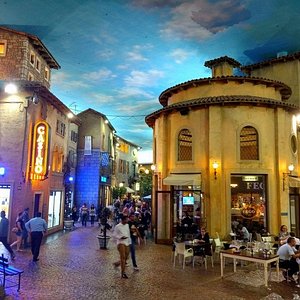The Greatest Guide To Johannesburg North Attractions
The Greatest Guide To Johannesburg North Attractions
Blog Article
The Ultimate Guide To Johannesburg North Attractions
Table of Contents8 Easy Facts About Johannesburg North Attractions ExplainedJohannesburg North Attractions Things To Know Before You Get ThisFascination About Johannesburg North AttractionsThe Johannesburg North Attractions DiariesJohannesburg North Attractions Things To Know Before You BuyThe Ultimate Guide To Johannesburg North Attractions
The city expanded on the edge of the Witwatersrand Key Coral reef, a subterranean stratum of gold-bearing quartz-silica conglomerate that arcs for hundreds of miles underneath the Highveld - Johannesburg North attractions. Most of the gold mines in the city ceased operation in the 1970s, yet in its day the Witwatersrand gold market accounted for more than 40 percent of the globe's annual gold production.Johannesburg has a pleasant environment. Summertime temperatures average about 75 F (24 C); winter season temperatures average regarding 55 F (13 C) and just sometimes dip listed below cold. The city enjoys about 8 hours of sunshine daily in both winter season and summer season. Rainfall standards concerning 28 inches (700 millimetres) per annum, however the complete differs significantly from year to year.
What rain the city gets falls virtually exclusively in the summertime months, frequently in magnificent late-afternoon electrical tornados., where several locals still rely on coal for fuel.

Unknown Facts About Johannesburg North Attractions
The balance of the city is occupied by whites. Lodging differs in personality and high quality. Soweto is notorious for its unlimited rows of municipally built, two-room matchbox homes, yet it also has a few prosperous territories in addition to bursting squatter camps, where 10s of thousands live without water, power, or hygiene centers.
Physical growth, although rather limited by transport, continued quickly as immigration to South Africa, and Johannesburg specifically, increased drastically. This issue was resolved in the 1930s when the auto was presented in mass manufacturing to South Africa. Automobiles were, essentially, confined to the affluent, and permitted them to relocate to the north of the city and commute into the centre.
The majority of inadequate residential areas were combined, with inadequate blacks and whites living with each other, although the rich suburbs were typically scheduled for whites. This altered with the political election of the National Party in the 1948 elections, who began to formalise the system referred to as apartheid. Apartheid formally designated which residential areas each race could reside in under the Group Areas Act.
The previous system of eleven phoned number regions was reorganised in 2006. Marshalltown, as seen from the top of the Carlton Centre. The M1 and M2 run behind the buildings, and the southerly suburbs extend past the freeway limit. The central city of Johannesburg lies within the city's Region F. The number of individuals living in the internal city on an informal basis is unidentified, as several are prohibited immigrants. The joblessness, education, and age accounts of the area are all unidentified, due to the difficulty of getting reputable details regarding the location.
Johannesburg North Attractions Things To Know Before You Get This
Centred on the CBD, the area consists of the suburban areas of Yeoville, Bellevue, Troyeville, Jeppestown, and Berea to the east. To the west it spreads out to Pageview (Johannesburg North attractions) and Fordsburg. There are small industrial locations to the south, such as City West-Denver and Benrose. Around 800,000 travelers travel through the central city on a daily basis, and it operates as a local shopping node for visitors from the southerly suburban areas. Yeoville and Bellevue have a mix of apartment and single domestic devices on small great deals. The region is located on a mountainous divide that ranges from why not try these out east to west. One of the most conspicuous geographical attribute is Observatory Ridge, which is named for the large observatory situated on it. The entertainment areas are no longer utilized, because of safety issues.

Johannesburg Arena, a training school for both the Golden Lions and Orlando Pirates, is nearby. The eastern suburban areas of Johannesburg lie in the city's 7th [] and 9th [] areas. The area is also functionally incorporated with East Rand border communities beyond the main border of Johannesburg, such as Bedfordview and Edenvale (both component of Ekurhuleni Metropolitan Community).
The 6-Minute Rule for Johannesburg North Attractions
R. Tambo International Airport). The eastern suburban areas are several of the oldest areas of Johannesburg, there are huge communities of Jewish and other European histories, most of the population is English speaking. There are three fairway along with a variety of protected ridges with viewsites. There are a number of strong and up-market entertainment and shopping areas in the east such as the Eastgate Buying Centre and the Greenstone shopping center.
Initially built to house male migrant employees, lots of have been boosted as houses for couples and family members. The residential area was not historically allowed to develop employment centres within the location, so practically all of its homeowners are commuters to other parts of the city.
Excitement About Johannesburg North Attractions
The N1 Western Bypass links the north suburban areas with the north-western residential areas. The domestic locations in the north residential areas are generally official, with no considerable locations of casual housing, or real estate that lacks an irreversible framework. Although this is a well-known area, there is a pattern Find Out More of land usage change from domestic to industrial, particularly along major arterial roads and around recognized nodes.
Roadways to the eastern and click here now west are less well established, as there are no highways travelling in that instructions. In the direction of the north border of the city, the thickness of development lowers, leaving large locations of primitive land around Midrand.
Some Ideas on Johannesburg North Attractions You Should Know
, which is located on a hillside neglecting the internal city and Hillbrow.
Report this page